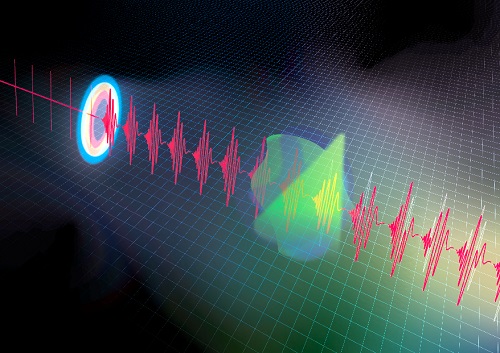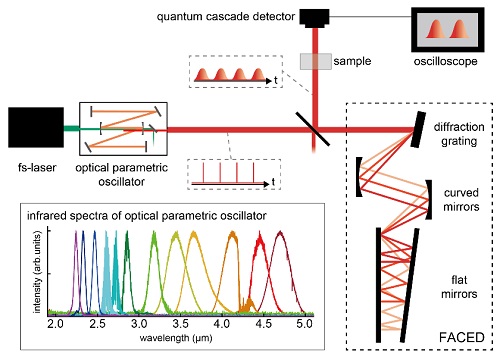
Infrared Spectroscopy Moves to the Fast Lane
Researchers at the University of Tokyo have developed a technique to drastically increase the speed of infrared spectroscopy. The technique, called time-stretch infrared spectroscopy, surpasses dual-comb spectroscopy nearly 10× over. The research could enable observation of very quick chemical reactions, as well as new applications in high-speed imaging or label-free flow cytometry.
“I have worked on developing dual-comb spectroscopy for a while and noticed its advantages and disadvantages, and realized that we need another technique to improve its measurement speed with higher sensitivity,” said Takuro Ideguchi of the Institute for Photon Science and Technology at the University of Tokyo.

Laser pulses lasting for mere femtoseconds are stretched to the nanosecond range. Courtesy of Ideguchi et al.
To achieve that end, Ideguchi sought some new time-increasing components: a time-stretcher and a detector. With those in hand, Ideguchi and his students started their experiment.
The laser pulse is stretched with a technique called free-space angular-chirp-enhanced-delay. The system consists of a grating, a pair of curved mirrors, and a flat mirror pair with a slight angle. The light is dispersed through the grating and relayed with the curved mirrors to the flat mirrors. At the entrance of the flat mirror, different colors have different incident angles.
“These light components reflect multiple times on the flat mirrors and finally reflect back to the same path,” Ideguchi said. “Since the different colors travel different paths, the output pulse gets stretched.”

The system consists of various optical components including lasers, mirrors, lenses, and detectors. It can detect wavelengths between 4.4 and 4.9 µm. Courtesy of Ideguchi et al.
The stretching of the pulse allows a detector to more accurately receive and analyze the signal. The detector, developed by one of the research paper’s authors, Tatsuo Dougakiuchi of Hamamatsu Photonics, is a quantum cascade detector, based on the quantum cascade laser. Because absorption and emission are opposite processes, Ideguchi said, they can use the semiconductor chip as both a detector and a laser.
The system is capable of reading 80 million spectra per second.
“This method, time-stretch infrared spectroscopy, is about 100 times faster than dual-comb spectroscopy, which had reached an upper speed limit due to issues of sensitivity,” Ideguchi said.
Ideguchi and his team envision the technology being used for the monitoring of rapid chemical changes and high-throughput measurement.
The research was published in Communications Physics (www.doi.org/10.1038/s42005-020-00420-3).
Published: September 2020